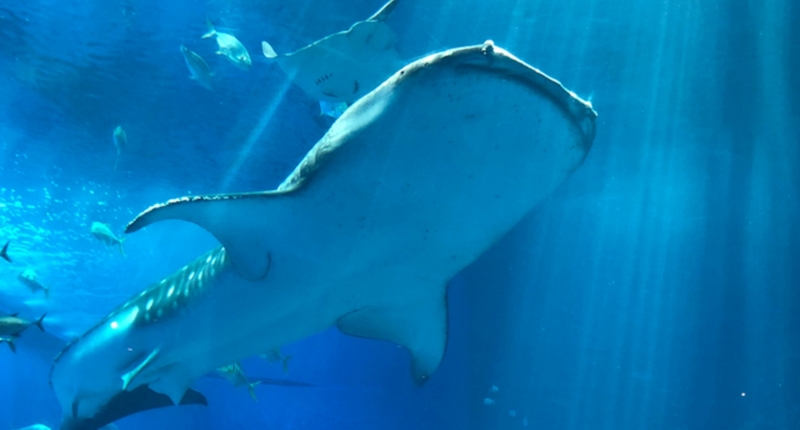Whale sharks have evolved their photoreceptor rhodopsin to improve their vision in low-light, deep-sea environments. Researchers have compared the genetic information and structure of the photoreceptor rhodopsin in whale sharks, zebra sharks, and brown-banded bamboo sharks, revealing that the whale sharks’ rhodopsin can efficiently detect blue light. Two amino acid substitutions have shifted the light spectra that rhodopsin detects, making it sensitive to blue wavelengths, although one of the substitutions is usually associated with a mutation causing congenital stationary night blindness in humans. These amino acid substitutions make the whale shark rhodopsin less thermally stable at 37 ºC than in other shark species. However, this unique adaptation is functional at deep-sea temperatures, suggesting that the whale sharks’ rhodopsin evolved to maintain functionality in the low-temperature, low-light deep-sea environment. This study not only provides valuable insights into the adaptation of the whale sharks’ rhodopsin but also demonstrates how genetic information and molecular biological techniques can be used to reveal the mysteries of these organisms’ lives.
How Whale Shark Rhodopsin Evolved For Low Light Environments.

A recent study conducted by the Osaka Metropolitan University Graduate School of Science has revealed that whale sharks (Rhincodon typus) have evolved their photoreceptor rhodopsin in a unique way to improve their vision in low-light, deep-sea environments. By investigating the genetic information and structure of the photoreceptor rhodopsin, researchers have gained valuable insights into how these creatures can see in extreme depths.
To understand the process of adaptation in the whale sharks’ visual system, researchers compared the whale sharks to zebra sharks, their closest relative, and brown-banded bamboo sharks, which belong to the same group known as the order orectolobiformes, commonly called carpet sharks.
The study showed that the whale sharks’ rhodopsin can efficiently detect blue light, the most common wavelength of light in the deep-sea. This is achieved by two amino acid substitutions that shift the light spectra that rhodopsin detects, making it sensitive to blue wavelengths. However, one of these substitutions is usually associated with a mutation known to cause congenital stationary night blindness in humans.
Furthermore, the research discovered that the amino acid substitutions make the whale shark rhodopsin less thermally stable, decaying rapidly at 37 ºC compared to rhodopsin in other shark species. However, this unique adaptation is still functional at deep-sea temperatures, suggesting that the whale sharks’ rhodopsin evolved to maintain functionality in the low-temperature, low-light deep-sea environment.
This study not only sheds light on the unique adaptation of the whale sharks’ rhodopsin but also provides valuable insights into how genetic information and molecular biological techniques can be used to gain insight into the mysteries of these organisms’ lives. It is particularly useful for studying wild or large animals that are difficult to observe in their natural habitat.
In conclusion, the adaptation of the whale shark rhodopsin is a remarkable feat of evolution that allowed these creatures to thrive in low-light, deep-sea environments. The study’s findings have implications for understanding how life on worlds circling dim M-class dwarfs might evolve their visual systems.
Don’t miss interesting posts on Famousbio









